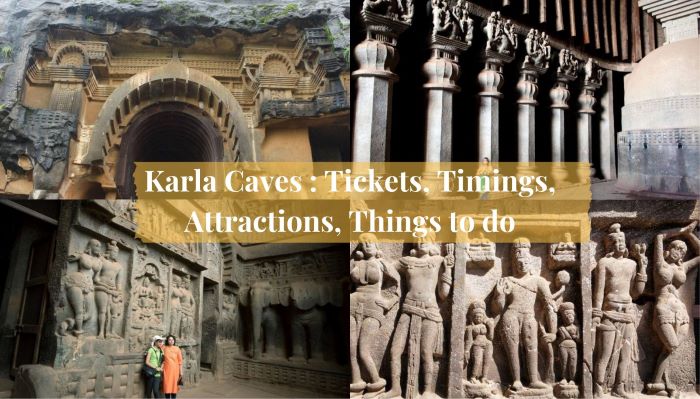
Karla Caves Ancient Rock-cut Caves in Maharashtra, India Despite the fact that these caves are over 2,000 years old and were originally constructed for Buddhist monks, people enjoy going there to appreciate the incredible architecture and designs. There is a main prayer hall, known as a Chaitya, within it. In it are long, stone pillars and the wooden ceiling looks somewhat like a ship’s hull turned upside down. This is one of the oldest and largest of its type in India. There are small rooms called Viharas in which monks used to stay and meditate. People, animals, and pictures of old stories can be seen on the carving on the walls.
The main entrance has an arch that is quite large and intricately carved. The caves were cut out from a hill side, which must have been some hard work then. They are a reflection of how expert people were, even without all the modern equipment. Karla Caves are a testament to India’s past and reflect the way art and worship merged. People visit the caves to view the beautiful carvings made and to derive lessons from the past. The caves remind one of the devotion of the monks who spent their time there and their love for peace and meditation.
Highlights
- State: Maharashtra, India
- Distance from Lonavala: 10.9 Kilometers
- Time requires for exploration: 1 to 2 hours
- Major attractions and specialties: Large Chaitya hall, stone pillars, wooden roof, Viharas, detailed carvings, grand entrance arch
- Best time to visit: November and March
- Worth Visiting: Definitely, visiting Karla Caves is totally worth it.
Table of Contents
Historical Importance of Karla Caves
Karla Caves are as old as 2,000 years and were created by Buddhist monks. They were the center for prayer, teaching, and meditation. Advanced skills can be seen in the carvings and architecture of the ancient craftsmen, with really impressive structures. An airy large Chaitya hall with stone pillars and a wooden roof showcases the artistic perfection of that time.
The caves were close to the ancient trade routes. It helped to expand Buddhism and connect people from various regions. The intricacies of the carvings, inscriptions, and other detailed art forms within these caves give deeper insights into how the culture was during that period. Stories and religious practices also found through them. Karla Caves reflect the significance of several eras in India’s history-the devotion of the monks and how Buddhism, its ideology, spread by the monumental art and architecture.
Architecture of Karla Caves, Maharashtra
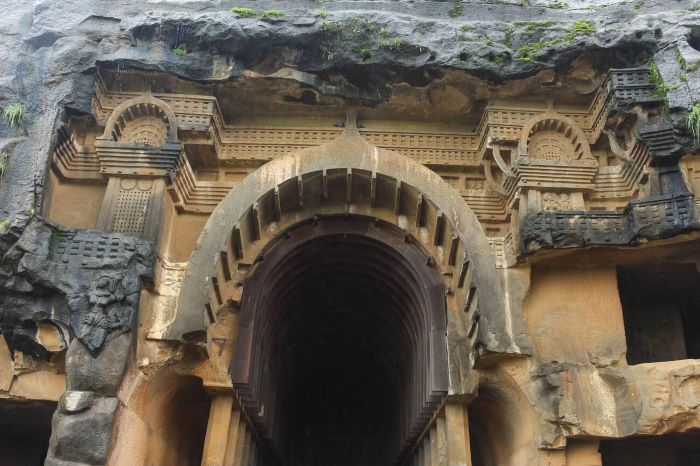
The Karla Caves in Maharashtra is architeturally impressive, and the technique reveals the craftsmanship of old builders. Rock-cut caves carved thousands of years back, the site remains an excellent example of early Buddhist art. The prime attraction is the gigantic hall that serves as the central prayer room, the Chaitya. There, one finds such structures that have stone pillars reaching the roof, giving the effect of an upside-down ship.
This wood working section is one of the oldest preserved in India. The entrance to the hall has an arch, decorated with carvings. Carved pillars in the inside are with images of people, animals, and stories from that period. Close to the Chaitya, there are smaller rooms called Viharas. These smaller rooms were used by monks to live and meditate. The whole structure was cut out from a hillside, thereby vindicating how difficult and technical the work was without modern equipment. The architecture of Karla Caves inspires the elegance and time-consuming efforts of ancient craftsmanship.
Karla Caves Park timings
| Days | Timings |
| Monday – Sunday | 9:00 AM – 5:00 PM |
Karla Caves Ticket Price
Ticket price or entry fee to Karla caves is INR 5.
Location and How to reach Karla Caves, Maharashtra
Karla Caves are located near Lonavala in Maharashtra which is about 120 kilometers from Mumbai and 60 kilometers from Pune.
How to reach:
- By Road: You can drive or take a taxi from Mumbai or Pune to Lonavala. From Lonavala it is about a 10-15 minute drive to the caves. There are also local buses available.
- By Train: The nearest railway station is Lonavala which is well-connected to Mumbai and Pune. From the station, you can take a taxi or auto-rickshaw to the caves.
- By Air: The nearest airport is Pune International Airport which is about 60 km away. From there, you can take a taxi or bus to Lonavala and then to the caves.
- By personal Vehicle: If you have your vehicle you can use Google Maps or other guided apps reach there.
Karla caves address: QFMC+858, Karla, एकवीरा देवी रोड, Lonavala, Maharashtra 410405
The Main Chaitya Hall: A Marvel of Ancient Rock-Cut Architecture

The main Chaitya hall at Karla Caves is a masterpiece of ancient rock-cut architecture. It was designed and built nearly 2,000 years ago by Buddhist monks. This is one of the biggest and oldest halls of this kind in India. The hall has been carved out directly from the hillside, as if to give proof of the great skill of early builders who worked without modern tools. The roof was wood, and it was full of strange boats, upside down. But inside the hall were tall stone pillars standing on both sides.
The stones are entirely covered with fine carvings of people, animals, and scenes from ancient stories. At the end of the hall is a large stone stupa where monks used to pray and meditate. The prominent entrance of the hall is characterized by a big arched door which is carved beautifully. The Chaitya hall in Karla Caves depicts technical superiority and a great deal of spirit the ancient Indians made use of in their work.
The Lion Pillars: A Signature Feature
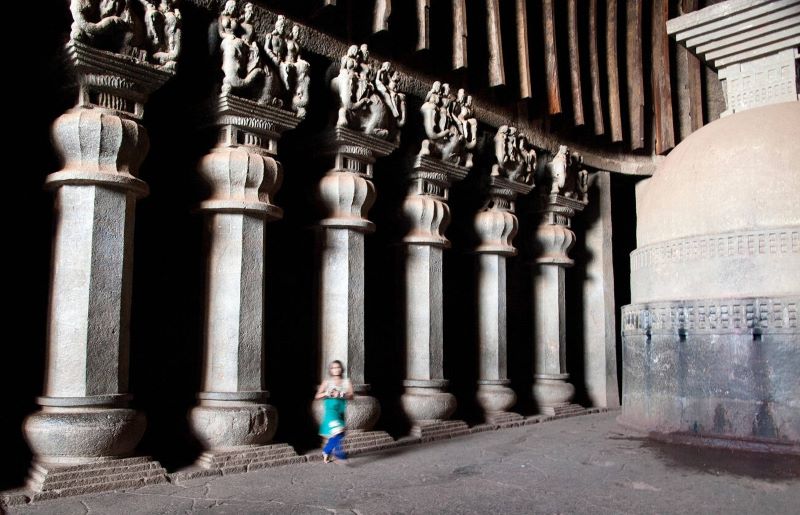
The Lion Pillars at Karla Caves represent the great and iconic heritage of this ancient site. They are the pillars of entrance and in the huge Chaitya hall. The master craftsmen employed their skills over 2,000 years ago to chisel these towers. These stony, towering pillars are represented by lions sitting on top, meaning both power as well as protection. These Lion figures add a vital element to the design of the pillars, creating more grandeur and meaning attached to the space.
Extremely artistic, lion pillars represent very spiritual and cultural aspects of the time. Intricate carvings inside depict dedication to the task and the strong influence of Buddhism teachings. The lions themselves could depict power and watch over all as they enter. These are pillars that testify to the beauty and mastery of ancient Indian rock-cut architecture and remain the excellence of the Karla Caves.
Major attractions of Karla Caves
Chaitya Hall

A big chamber in a mountain is carved to get Chaitya Hall. The ceiling is high, and its shape is rounded like a cave. The stupa, which can be called a small temple, is situated in the central part of it. Full beautification with carvings of Buddha along with other symbols adorns the walls. People used to pray and meditate here. It is a very peaceful hall, and how it is made makes it nice to hear people sing or chant inside. It’s a cool place to see and learn.
Main Cave
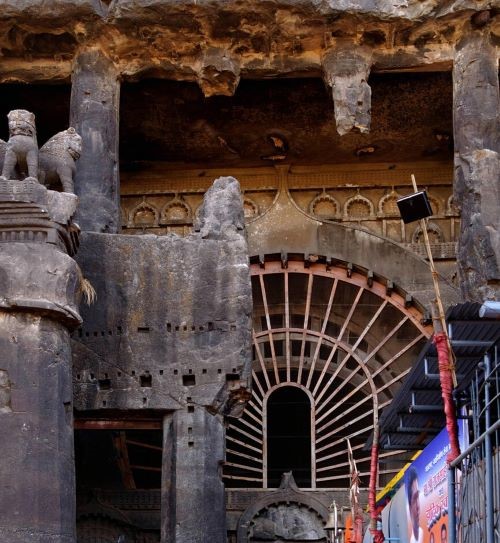
The largest and most significant cave in Karla Caves is the Main Cave. In this cave, there is a huge hall where most of the people would often pray and meditate. The cave was beautifully designed with tall pillars and details carvings on the walls. A stupa, which is a small structure for worship, is found at the center of the hall. Pictures and carvings about the stories of Buddhism adorn the walls and ceiling.
Brahmi Inscriptions

There are very old Brahmi inscriptions found within the Karla Caves. They are marked on the walls and give a history of the caves. The inscriptions are written in the oldest Indian script – Brahmi. These inscriptions were made by people who were supporting Buddhism, and talks regarding donations for building the caves. The inscriptions are a good aid to historians in terms of knowing how people lived and how they practiced Buddhism way back. They were important because they were among the oldest writings that could be found in India.
Sculptures and Carvings
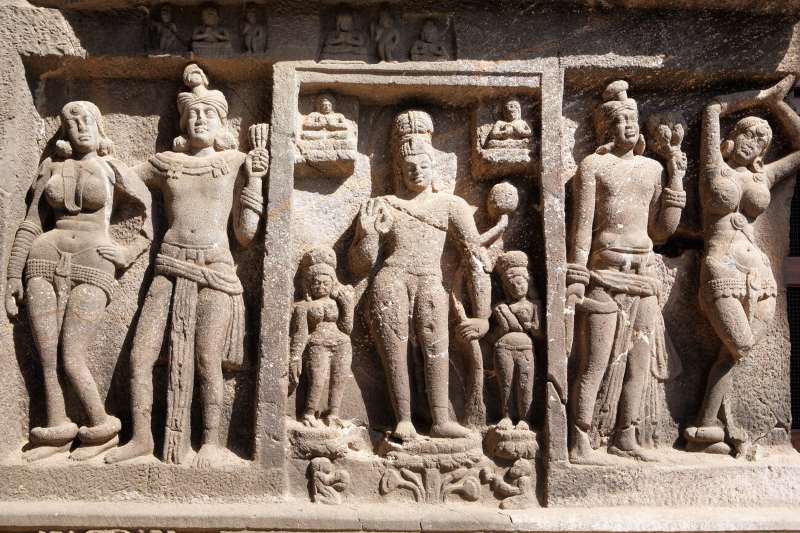
The Karla Caves are filled with a lot of beautiful sculptures and carvings. These are pictures and figures carved on the stone walls. While some of the carvings portray scenes from the life of Buddha, others represent various Buddhist symbols. Some images carry representations of gods and animals. The sculptures are well-detailed and evince superb craftsmanship on the part of the artists who made them. These carvings were made to educate people about Buddhism and to add beauty to the caves. People who go into these caves can see how these artists have utilized the natural rock to make such great art.
Stupa

A stupa is some kind of small, rounded structure located inside the Karla Caves. It is an important part of Buddhist tradition. People used the stupa as a space for worshipping and meditating. Inside the stupa lies relics: in most cases, small pieces of Buddha’s belongings or other sacred things. The stupa of Karla Caves is located in the main hall. Around it are very beautiful carvings. It’s like an oasis of peace where people might reflect or connect with Buddhist teachings. The stupa is sometimes called a mandala, meaning peace, wisdom, and the words of Buddha.
Viewpoints
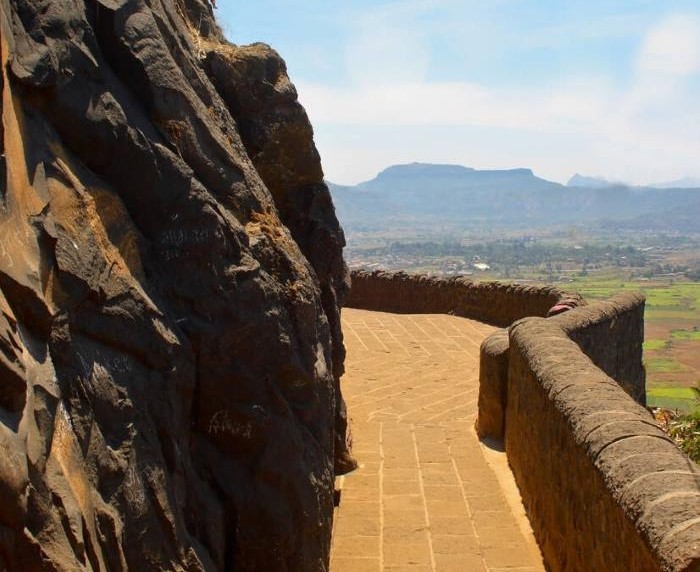
The Karla Caves have a couple of great viewpoints with exceptionally lovely hill and valley views. Once you climb up the caves, you feel the fresh air and really would like to look out over the whole green area below. It is so great at any time during early mornings or late afternoons when sunshine has made the scene even more gorgeous. These viewpoints are perfect for clicking a few photos and relaxing while looking upon the beauty of nature. The peacefulness and the wide-open views of the place make it an excellent place to sit and enjoy the beauty of the place.
Suggested read : 16 amazing facts about Mumbai that you must know
Interesting things to do in Karla Caves
Here are some interesting things to do in Karla Caves:
- Explore the caves: Walk through the caves and look at the detailed carvings, statues, and paintings.
- Visit the Chaitya Hall: Spend time in the large prayer hall which is known for its beautiful design and peaceful atmosphere.
- Climb to the caves: Enjoy the short climb up to the caves, which offers lovely views of the surrounding area.
- Photograph the art: Capture the detailed carvings and the impressive architecture of the caves.
- Enjoy the views: From the caves, you can see panoramic views of the hills and valleys around Karla.
- Learn about Buddhism: Take time to understand the history and importance of the site.
Influence of Buddhism on the Caves
Buddhist influence has been very strong in Karla Caves. The caves were built around 2,000 years ago by the Buddhist monks. These serve as the meditation and prayer halls. The exquisite carvings as well as stunning paintings that adorn the Karla Caves also feature scenes from the life of Buddha. The main cave is referred to as “Chaitya,” a large hall featuring a carved entrance and a stupa positioned in the center. Viharas” were smaller caves that housed the monks’ living quarters. The simple, serene design of these caves enabled the monks to focus on their meditation. An excellent example of how Buddhism affected art and architecture in India is represented by the Karla Caves.
Important Inscriptions Found in Karla Caves
Significant inscriptions discovered at the Karla Caves Many of these inscriptions are in Brahmi script and date back to approximately the 1st century BCE. They are on the walls of the caves and provide highly valuable information regarding the historical and cultural setting of the period. Some of the inscriptions identify the donor names who contributed to the constructions of the caves, hence showing local community participation in Buddhism. Other inscriptions relate to the offerings made to the monks and the building of the cave complex. With these, historians can also understand how Buddhism spread and developed through the patronage of native chieftains and traders.
Know more things about Karla Caves
Fun Facts about Karla Caves
- The Karla Caves are over 2,000 years old and built around the 2nd century BCE.
- The main cave has the largest prayer hall (Chaitya) of its kind in India.
- There are ancient Brahmi inscriptions inside the caves which tell us about early Buddhism.
- Rich merchants and kings helped build the caves because they supported Buddhism.
- The caves offer stunning views of the hills and valleys around them.
- Monks used the caves for meditation.
- The entrance to the main cave is carved to look like wood, which is very unique.
Is it worth it visiting Karla Caves?
Karla Caves are no doubt a must-visit place, since the caves represent magnificent ancient Buddhist architecture. There is outstanding carving and painting of episodes taken from Buddha’s life. The chief hall with its stupa makes it really fantastic to explore. The peaceful surroundings will make it worthwhile for a quiet visit. The climb on the way to the caves offers breathtaking views of the area. For history, culture, and architecture fans, Karla Caves must be visited to have a glimpse of ancient Indian life and Buddhism.
Suggested read : Amazing 10 things to do in Sanjay Gandhi National Park
Time required for exploring Karla Caves
The total time needed to view the Karla Caves is about 1 to 2 hours. It would take roughly half an hour reaching the caves climbing the steps. After arriving at the site, one could take as much time as desired contemplating on the marvellous carvings and paintings and spending time in the main hall. It’s great getting some rest and enjoying the calm air around. If one takes some time to contemplate and be able to understand what is present at the site, then 1 to 2 hours would be sufficient to visit the entire place.
Best time to visit Karla Caves

The best season to visit Karla Caves is from October to March, when it’s cooler and friendly enough for walking. This period brings quite pleasurable temperatures for outdoor activities such as climbing up the stairs into the caves. Summer is not considered the right time of the year for a visit as temperatures can reach high levels by midday. Winter is also known for clearer skies and panoramic views in the surroundings, hence preferred for travel.
Tips for visiting Karla Caves
- Wear Comfortable Shoes: The climb to the caves involves many steps so wear sturdy and comfortable footwear.
- Carry Water: Bring enough water to stay hydrated especially if you’re visiting in the warmer months.
- Visit Early or Late: Arrive early in the morning or later in the afternoon to avoid the midday heat and crowds.
- Respect the Site: Be mindful of the sacred nature of the caves. Avoid loud noise and littering.
- Carry Sun Protection: Use sunscreen, hats, or sunglasses, as there’s limited shade on the way up.
- Bring a Camera: Don’t forget your camera to capture the stunning views and intricate carvings.
- Take Your Time: Take your time to explore the cave and know about the history and peaceful atmosphere.
Who should visit Karla Caves?
- History Enthusiasts: Those interested in ancient Buddhist history and architecture.
- Nature Lovers: People who enjoy lovely views and peaceful surroundings.
- Cultural Explorers: Visitors wanting to learn about India’s rich culture.
- Photography lovers: Perfect for capturing beautiful carvings, structures, and natural landscapes.
- Trekking and Adventure Seekers: Those who enjoy climbing and exploring historic places.
- Spiritual Seekers: People looking for a peaceful place for meditation and reflection.
Nearby attractions from Karla Caves
Here are some nearby attractions to Karla Caves and their distances:
- Bhaja Caves – 10 km
Another ancient Buddhist caves and it is similar to Karla which is known for their carvings and peaceful atmosphere. - Lohagad Fort – 15 km
A historic fort offering fantastic views and perfect for hiking and photography. - Dudhiware Waterfall – 18 km
A beautiful waterfall located near Lonavala and perfect for a refreshing stop. - Rajmachi Fort – 25 km
A popular trekking spot with stunning views of the surrounding hills and valleys. - Tiger’s Leap – 16 km
A viewpoint offering panoramic views of the lush green valley and forests.
Conclusion: Why Visit Karla Caves
Visiting the Karla Caves is a great experience for all history, culture, and architecture lovers. The great thing about these caves is that they give a glimpse into old times of Buddhist life which beautifully shine through the carvings, paintings, and wonderful structures. Of all, the central cave impresses one with its huge prayer hall and stupa. As you walk through the place, you feel how the monks used to meditate and pray inside those caves.
It is a perfect place for silent contemplation in this peaceful environment. Also, the vistas are excellent as far as the caves are concerned because of the surrounding hills and landscape, which make it simply beautiful. Not visiting Karla Caves means that you are not seeing ancient art but will surely relate with the past in understanding the role Buddhism played in defining India’s culture. Whether you are a history enthusiast, someone who loves culture, or just someone looking to visit a refreshing place, the Karla Caves surely promise a journey into India’s deep spiritual and architectural heritage.
Is there parking available at Karla Caves?
Yes, there is a parking area near the caves for visitors traveling by car.
Are the caves accessible for physically challenged visitors?
The caves require a climb of about 150 steps, so it may be challenging for visitors with mobility issues.
Can I visit Karla Caves on a day trip?
Yes, Karla Caves are perfect for a day trip from Mumbai or Pune. You can easily explore the caves in a few hours.
What should I wear to visit Karla Caves?
Comfortable shoes are recommended, as you’ll be walking and climbing stairs. Light, casual clothing is ideal, especially in warm weather.
How do I reach Karla Caves?
You can reach Karla Caves by road from Lonavala which is about 10-15 minutes away. Lonavala is accessible by train from Mumbai or Pune, and the nearest airport is in Pune.
Know more about Karla Caves.